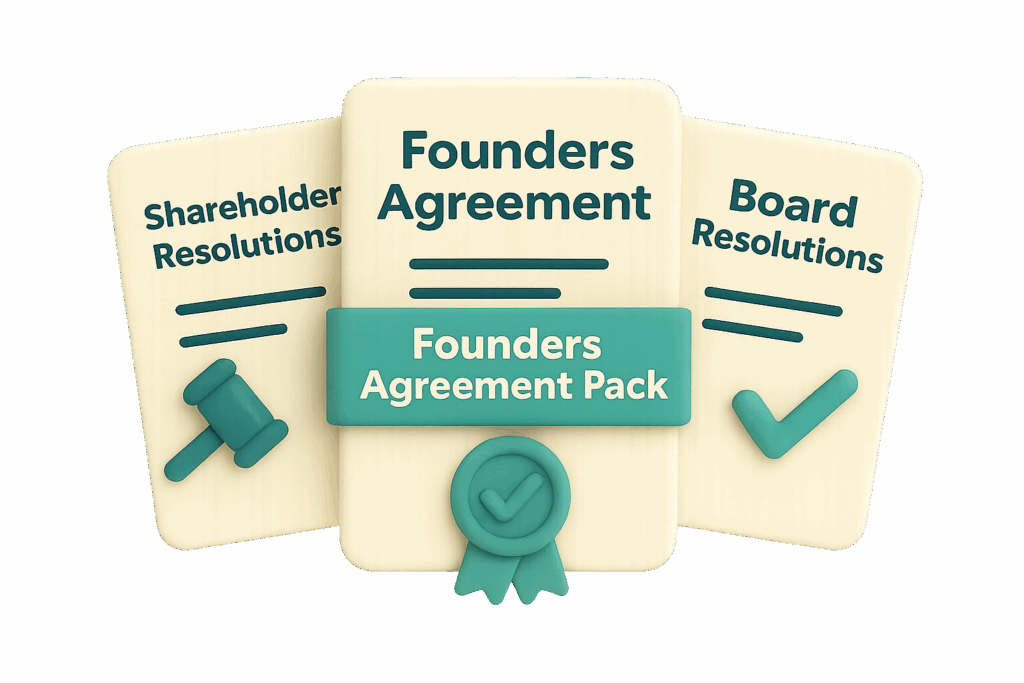Early equity decisions echo for years. We lock the rules now – ownership, leavers, decision-making, so the company keeps moving when life happens.

When to use a Founders Agreement
It’s time to put a founders’/shareholders’ agreement in place if any of these ring true:
- You have more than one founder and want vesting and leaver rules that won’t blow up a round later.
- An investor has asked for a shareholders’ agreement before term sheet.
- You’re hiring or using contractors and need IP, confidentiality and competition rules aligned.
- A founder is joining, or leaving, and you need a fair, documented path.
Pricing
We price this as a fixed fee you approve up front. Two common routes:
- Add-on to Start Essentials: typically +£900 (ex VAT) for a standard founders’ agreement with vesting and leaver rules.
- Standalone scope: fixed fee agreed after a short discovery; typical range £1,250-£1,550 depending on cap table complexity and required articles changes.
Prefer something more tailored? We’ll scope a bespoke bundle against our standard rates (£275/hr) and convert it into a single fixed fee. No meter running.
Timeline
Discovery call, then scoping the same day. First draft within three working days once inputs from you land. We iterate quickly; signing follows board/shareholder approvals. If articles need changes, we fold that work into the plan and keep the timetable tight.
Founder agreement inputs we’ll need

To scope and draft fast, we’ll need a few essentials from you:
- Names, roles, and current cap table (including options/promises).
- Your view on vesting length, cliffs, and any existing time served.
- A list of decisions you want board/shareholder control over (we’ll propose a sensible set).
- Your current articles and any investor asks you’ve heard already.
Common FAQs
Will a founders agreement replace or conflict with our articles?
A founder agreement must be drafted to align the agreement and articles so they work together. Where articles need a tweak, we draft the change and run the approvals.
Can vesting credit time already served?
Yes. We often recognise prior months with a shorter cliff or partial credit, while still protecting the company if someone leaves next quarter.
What if a founder leaves on bad terms?
The agreement sets the price and process in advance. We document the exit cleanly—buy-back or transfer—and tidy the registers so the round isn’t haunted later.
Understanding Founders’ Agreements

A founders’ agreement, call it a shareholders’ agreement if you prefer, should exist before tempers ever have a chance to. I’ve watched teams get through rough patches because the paper was clear. I’ve also watched bright companies lose a fortnight to one fuzzy clause. Our aim is deliberately dull in the best way: vesting that ticks over, exits that don’t explode the group chat, decisions made in daylight.
The heart of the job is simple: who owns what today, how that shifts over time, and what happens if someone leaves. Vesting should reward the people actually building. Good, and, bad-leaver rules need to be fair and enforceable. If a founder steps away, the price for returning their shares shouldn’t be made up on the spot. Put it in writing now; save the arguments later.
Decision-making matters as much as equity. A short list of reserved matters gives control over the big swings—new share issues, major spend, changes to rights – without choking everyday life. Drag-along and tag-along should help, not trap. They exist so real exits can happen, not to hand out vetoes for sport.
We also check the plumbing: pre-emption rights, clean transfer mechanics, and whether your articles back the deal. If the articles need an edit, we draft it. If the cap table needs a sanity check, we mark it up and show the before/after so everyone is looking at the same picture.
You can Google a shareholders’ agreement solicitor and find templates. They rarely match your stage, your team, or your investor’s asks. We write in plain English, explain trade-offs in a couple of lines, and keep drafts moving. You finish with signatures in place, articles aligned, registers tidy, and a cap table you’re comfortable putting in the deck, so you can get back to building.


